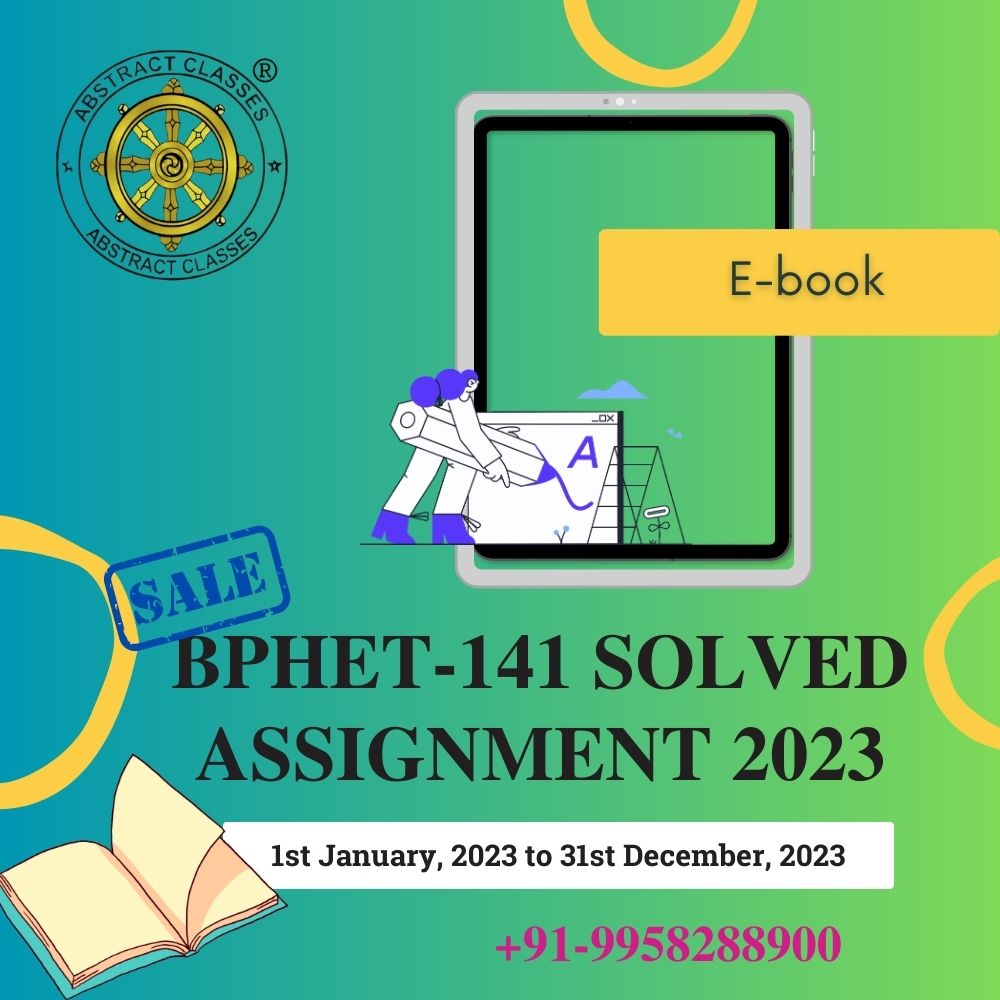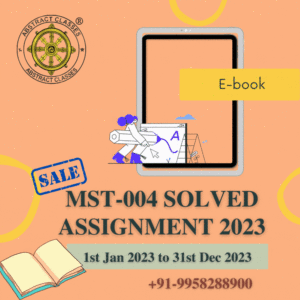
IGNOU BPHET-141 Solved Assignment 2023 | B.Sc. CBCS
₹101.00
Access via our Android App Only
Please read the following points before ordering :
Share with your Friends
IGNOU BPHET-141 Assignment Question Paper 2023
BPHET-141 (ELEMENTS OF MODERN PHYSICS)
(Valid from 1st January, 2023 to 31 st December, 2023)
PART A
1. a) A muon produced in the earth’s atmosphere is travelling with a speed of \(0.80 \mathrm{c}\). As measured in the muon’s frame of reference it has a lifetime of \(1.6 \mu \mathrm{s}\). What is it’s lifetime as measured by an observer on earth.
b) A space ship is measured to be \(180 \mathrm{~m}\) long on the ground. When in flight, its length is measured as \(150 \mathrm{~m}\) by an observer on the ground. What is its speed?
c) Two \(\beta\)-particles move in opposite directions with velocities of \(0.7 c\) in the laboratory frame. Calculate the velocity of one \(\beta\)-particle in the moving frame attached to the other \(\beta\)-particle.
d) A light source emits light of wavelength \(550 \mathrm{~nm}\) while at rest. When the source is moving, the Doppler shifted wavelength of the emitted light is \(430 \mathrm{~nm}\). Is the source of light approaching us or receding from us? Also calculate its speed.
e) Show that when the kinetic energy of a relativistic particle is equal to its rest energy, the speed of the particle is around \(0.866 \mathrm{c}\).
2. a) The stopping potential observed in a certain experiment on photoelectric effect is \(8.0 \mathrm{~V}\). Calculate the maximum kinetic energy and maximum speed of the photoelectrons.
b) Calculate the de Broglie wavelength of an electron in the first Bohr orbit of the hydrogen atom.
c) Estimate the minimum kinetic energy a neutron confined to a nucleus of diameter \(4 \times 10^{-15} \mathrm{~m}\) may have.
d) Show that the wavefunction \(\psi(x)=N \sin k x+i N \cos k x\) is an eigenfunction of the momentum operator.
e) In a region of space a particle has a wavefunction
\[
\psi(x)=\left\{\begin{array}{cc}
A \cos \left(\frac{2 \pi x}{L}\right) & \text { for }-\frac{L}{4} \leq x \leq \frac{L}{4} \\
0 & \text { elsewhere }
\end{array}\right.
\]
Determine the normalization constant \(A\).
PART B
3. a) A particle is in a one dimensional box of length \(a\). If the particle is in the ground state, obtain \(\Delta x\), where \((\Delta x)^2=\left\langle x^2\right\rangle-\langle x\rangle^2\).
b) A particle encounters a step potential of height \(V_0\). Calculate the reflection and transmission coefficient if \(E=1.5 V_0\) ?
c) Calculate the transmission coefficient for an electron of energy \(2.0 \mathrm{eV}\) incident on a potential barrier of \(2.5 \mathrm{eV}\), if the width of the barrier is \(0.50 \mathrm{~nm}\).
d) For a symmetric potential function show that the parity operator commutes with the Hamiltonian.
4. a) Determine B.E. per nucleon for \({ }_{28}^{68} \mathrm{Ni}\) given that the mass of \(\mathrm{Ni}\) is \(63.9280 \mathrm{u}\), \(m_p=1.007825 \mathrm{u}, m_n=1.008665 \mathrm{u}\) and \(m_e=.00054857 \mathrm{u}\).
b) The half-life of an element \(C^{14}\) is 5370 yrs. Detrmine after how much time \(40 \%\) of this sample would have decayed?
c) Show that for light nuclei, the fact that \(Z \cong N\) is explained by the semi empirical formula.
d) Calculate the activity of \(1 \mathrm{~g}\) sample of \(\mathrm{Sr}-90\) whose half life is 28 years. Express your answer in units of Curie \((\mathrm{Ci})\). Take \(1 \mathrm{Ci}=3.7 \times 10^{10}\) disintegrations \(\mathrm{s}^{-1}\).
e) Calculate \(Q\) value of the following nuclear reaction.
\[
{ }_{13} \mathrm{Al}^{27}+{ }_2 \mathrm{He}^4 \rightarrow{ }_{14} \mathrm{Si}^{30}+{ }_1 \mathrm{H}^1
\]
Take \(m\left({ }_{13} \mathrm{Al}^{27}\right)=26.9815 \mathrm{u}, m\left({ }_{14} \mathrm{Si}^{30}\right)=29.9738 \mathrm{u}, m\left({ }_2 \mathrm{He}^4\right)=4.0026 \mathrm{u}\) and \(m\left({ }_1 \mathrm{H}^1\right)=1.0078 \mathrm{u}\).
BPHET-141 Sample Solution 2023
Frequently Asked Questions (FAQs)
You can access the Complete Solution through our app, which can be downloaded using this link:
Simply click “Install” to download and install the app, and then follow the instructions to purchase the required assignment solution. Currently, the app is only available for Android devices. We are working on making the app available for iOS in the future, but it is not currently available for iOS devices.
Yes, It is Complete Solution, a comprehensive solution to the assignments for IGNOU. Valid from January 1, 2023 to December 31, 2023.
Yes, the Complete Solution is aligned with the IGNOU requirements and has been solved accordingly.
Yes, the Complete Solution is guaranteed to be error-free.The solutions are thoroughly researched and verified by subject matter experts to ensure their accuracy.
As of now, you have access to the Complete Solution for a period of 6 months after the date of purchase, which is sufficient to complete the assignment. However, we can extend the access period upon request. You can access the solution anytime through our app.
The app provides complete solutions for all assignment questions. If you still need help, you can contact the support team for assistance at Whatsapp +91-9958288900
No, access to the educational materials is limited to one device only, where you have first logged in. Logging in on multiple devices is not allowed and may result in the revocation of access to the educational materials.
Payments can be made through various secure online payment methods available in the app.Your payment information is protected with industry-standard security measures to ensure its confidentiality and safety. You will receive a receipt for your payment through email or within the app, depending on your preference.
The instructions for formatting your assignments are detailed in the Assignment Booklet, which includes details on paper size, margins, precision, and submission requirements. It is important to strictly follow these instructions to facilitate evaluation and avoid delays.
Terms and Conditions
- The educational materials provided in the app are the sole property of the app owner and are protected by copyright laws.
- Reproduction, distribution, or sale of the educational materials without prior written consent from the app owner is strictly prohibited and may result in legal consequences.
- Any attempt to modify, alter, or use the educational materials for commercial purposes is strictly prohibited.
- The app owner reserves the right to revoke access to the educational materials at any time without notice for any violation of these terms and conditions.
- The app owner is not responsible for any damages or losses resulting from the use of the educational materials.
- The app owner reserves the right to modify these terms and conditions at any time without notice.
- By accessing and using the app, you agree to abide by these terms and conditions.
- Access to the educational materials is limited to one device only. Logging in to the app on multiple devices is not allowed and may result in the revocation of access to the educational materials.
Our educational materials are solely available on our website and application only. Users and students can report the dealing or selling of the copied version of our educational materials by any third party at our email address (abstract4math@gmail.com) or mobile no. (+91-9958288900).
In return, such users/students can expect free our educational materials/assignments and other benefits as a bonafide gesture which will be completely dependent upon our discretion.
Related products
-
IGNOU Assignment Solution
IGNOU MEG-15 Solved Assignment 2022-2023 | MEG | Comparative Literature: Theory and Practice
₹101.00 Go to the App -
IGNOU Assignment Solution
IGNOU MEG-09 Solved Assignment 2022-2023 | MEG | Australian Literature
₹101.00 Go to the App




